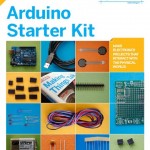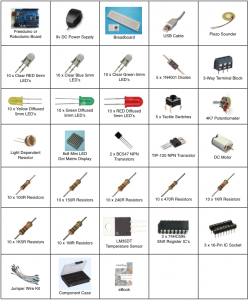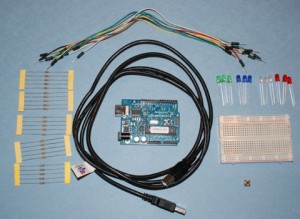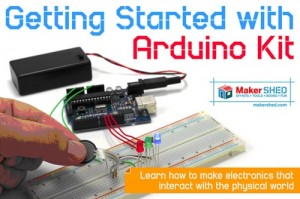
Update: A useful comparison chart of Arduino Starter kits has been posted (by me) at ConductiveResistance.com. I invite you to check it out there.
When I wrote the first part of this series, I didn’t plan for it to be a series. I was just thinking about a couple of Electronics companies that I like that sold a product that I like. It turns out though, that there’s a deeper need for this kind of article. A mostly-comprehensive look at Arduino sets that will spell out what has what, and how they compare. I got one concern that I’d only looked at American companies. So I’ve dove in and I’m giving you no fewer than 5 more Arduino starter kits. Two more from North American providers, and Three from European providers. All different, and all cool. We’ll see if we can get a good list to help folks out.
Disclaimers: I wrote this over two weeks. I tried my best to make it look nice, and be readable. Sorry if it’s not. Also, I started out with 4 European provides, but only ended up with 3. They’re all actually from the UK. I hope that doesn’t cheese anyone off. Anyway, on with it all.
First, let me say that looking at some of these kits, it’s clear that “Starter” doesn’t mean the same thing to everyone. To some, it means “Beginner”, to others it means “Introductory”. The difference is that some kits are put together for the person who’s not familiar with Arduino and how it works. Other kits are built to get you up and running with an Arduino. They give you lots to work with, cool things to do, but not the know-how or “already have”-ness that you get from being an Electronics hobbiest. I’m not going to differentiate here, except in the conclusion, where I’ll lay out which kits seem to fall into which category.
Kits are listed by their providers, as they’re pretty much all called “Arduino Starter Kit”; Providers are in alphabetical order…
All kits contain an Arduino Duemilanove board with an ATMega328 unless otherwise noted.
Cool Components
The Cool Components starter kit is a neat looking kit, and has a few surprises in it. Forgive me for the pun, it definitely has some cool components in it. It weighs in at $80.10 (US), They’re based in the UK though, so you’re probably expecting something in pounds: £48.22 is the magic number.
1 x USB cable – This is kind of a given… Looks to be 3′ from the picture.
2 x Mini breadboards – I expected 1, two sweetens the deal here. You can either work on two small projects, or have on projects separated into sections. I like this.
1 x Male & Female Jumper Leads – I think the 1x refers to “1 pack of jumpers” The photo looks to have about 10 of them. While Male jumpers are fantastic, I’m not sure how Female jumpers are going to be put to use here. You could connect the directly to the sensors, but then you’ll still have to use Male jumpers to connect them the Arduino, or to the Breadboard.
6 x LEDs (mix of red, green, yellow) – A good mix of LEDs, nothing special though.
2 x 15 degree Tilt Switches – This is a very cool addition, and a slightly unexpected one. I’d love to play with some tilt-switches, but I kind of wonder why these were thrown in…
Resistors (220, 10k, 200k Ohm – 5 each) – Always good to have a mix of resistors to work with, especially if you’re giving people breadboards to plug stuff into.
2 x 1N4007 Diode – You will thank your lucky stars when you don’t fry a valuable component because the current decided to go the other way. Diodes are nice to have…
4 x BC547 NPN Transistors – Transistors are the basis of modern electronics. They are in everything, including quite a few in that Arduino up there. While they’re definitely cool, I’m not sure about their inclusion here. Most of what you do with transistors can be easily accomplished with Arduino programming, and most projects aren’t going to be large enough or complex enough to encourage the use of Transistors. That said, they’re a basic component of learning electronics, so why not?
2 x Opto-isolators – I didn’t know what an Opto-isolator was until a few minutes ago. It’s a little IC that has an LED (InfraRed) and a little photodetector (or light sensor) that’s all wrapped in a light-tight housing. You can use them to eliminate electrical noise or to transmit signals between different voltages.
1 x Piezo buzzer – Make noise! Because you can! A great little addition, because it’s so easy to use, and so obnoxious. 🙂
The Cool Components package is cool, but seems to be suffering from a kind of identity crisis. Is it a beginners electronics package, or a beginner’s Arduino package? The price feels a little high to me, but I’m not familiar enough with UK electronics economy to tell. It turns out Cool Components doesn’t sell individually a lot of the components listed in the kit, so I couldn’t get a very accurate price for individual parts. My guestimate comes to about £44.00, which is less than they sell the kit for…
EarthShine Design
Freeduino Board (100% Arduino Compatible Clone) – “What does that mean!?!” You say… It means that your Arduino is not an official Arduino board, but instead, a compatible board. It doesn’t say on the site, but I’m guessing they give you this board, instead of this one. What does that mean for you? It means your board will be orange instead of blue. The Freeduino board is 100% compatible with all hardware and software for the Arduino. The people who created Arduino intended the design to work like that. There’s a whole bunch of different Arduino-compatible boards out there. Anyway, the point of all this is: Don’t shy away from this because it’s not an official Arduino board. You can still do everything you want with zero problems.
USB A to B Cable – Don’t know how long. Expect 3′ to be on the safe side.
“The Complete Beginners Guide to the Arduino” eBook – According to the listing, this book has more than a dozen projects for you to do with your new Arduino. Smart to make it an eBook. Additionally, there are links to code provided. Note: Mike, who runs Earthshine Design and is very active in the Arduino Community, has decided to release this book freely. This is way cool as it provides a learning opportunity not limited to only those who buy the kit. I think this is a great way to promote Earthshine and provide something for the community. You can get the book here.
9v DC Power Supply (UK Socket) – A UK plug to get the power you need for your Arduino.
Full Size (700 tie points) Breadboard – This is a welcome addition. A full size breadboard. I like the mini-boards, but it’s nice to know there’s someone out there considering what you’re trying to do.
Red Diffused, Green Diffused, Yellow Diffused, Red, Green, Blue LEDs (10 each) – Yeah, that’s 60 LEDs right there. The latter 3 are clear.
100, 150, 240, 470, 1k, 1k5, 1M Ohm resistors (10 each) – For someone getting started (as I’m sure I mentioned before), having a good selection of resistors is essential. I’m glad to see the wide range.
5 Tactile Switches – Buttons!
74HC595 Shift Register IC’s (3) – Shift registers are a good way to multiply pins you don’t have. You can turn 8 pins into just 3, saving you 5 pins to use else where. Great if you’re working with a component that takes a lot of pins (LCD screens for instance)
Turned Pin 16-Way IC Sockets (3) – So you don’t have to solder those Shift registers…
BC547B NPN Transistors (2) – A couple of transistors for amplifying or… something
TIP-120 NPN Transistor – I’m not sure about the inclusion of this, as I don’t really know the differ
8×8 Mini LED Dot Matrix Display – A nifty inclusion. The one they offer in their shop they note it’s easy to control via a shift register (included above)
LM35DT Temperature Sensor – Rises an falls in temperature could provide for some cool projects.
Light Dependent Resistor – Almost a given in a starter kit
4K7 Potentiometer – Another common item. Nice to have.
DC Motor – This one is a bit of a surprise to me, as A motor isn’t a common thing to include. It’s defintely a nice addition, but there’s no H-bridge in the kit for motor control. I don’t know the project they have in mind when they include this, don’t expect anything but basic on-off motor…
3-Way Terminal Block – This is a block screw down posts to make it easy to connect and disconnect wires to an from connections. Useful during prototyping.
Piezoelectric Sounder – Make noise with this… but don’t plan on it being pretty.
75 Piece Molded-End Jumper Wire Kit – I think it goes without saying that you need wires.
Quality 7 Compartment Raaco Case – This is a great point of all of these kits. If you’re getting started in electronics, you’ll quickly find that the random doodads that you’re picking up have nowhere to go in your house. Having a little case to stick them in is really indispensable.
This is a BIG kit. A lot bigger than what I was expecting for a starter kit. The strength of the kit lies in the projects that they give you to do. More than a dozen projects to learn with and the components that you need to complete them. I think as you go through these projects you’ll find that you’re learning the things that you need to make your own projects, and realize the things you’d like to build. The price for the kit is £49.99 or about $81.00 US. A parts breakdown, makes it more than £53.00 (Not all parts were available to price), so you do get a price break. However, it is a little high when you’re looking to get into the basics.
Hacktronics
Solderless Breadboard – A bit bigger than the kits reviewed so far, it’s nice to have what I’d call a “project breadboard”. It has room enough for an entire project, which I think would largely be
12 Flexible Wire Jumpers – All Male it looks like, which is good.
Red, Green, Blue & White (5 each) – LEDs are great fun. These are all diffused (they look like the color they give off)
330, 680, 1k, 4.7k, 10k Ohm Resistors (5 each) – A wide selection of resistors is great.
1 Tactile Push Button – Many of the cool things that you’ll want to do has to do with pressing buttons to get responses out of the Arduino.
1 USB Cable for programming and powering the board – From the picture, it looks to be a 6 foot cable.
This is a good kit for basic Arduino experimentation. You could make a few projects with LEDs that respond to a button-press. I don’t see a lot of flexibility beyond that though. The sells for $39.85. Parts breakdown total is $49.25 (The breadboard in the kit doesn’t appear to be for sale on the site, so I substituted the closest similar…)
MakerShed
MakerShed is the store corner of Make Magazine, and a way for them to provide parts and materials for the projects they show off in the magazine. When I started writing this I was actually looking at the kit they’re retiring. They’ve since replaced it with 3 kits for different needs: The Arduino Projects Pack, the Advanced Arduino Starter Kit, and this one – the Getting Started with Arduino Kit. If you get a chance, I recommend you look at all three as they vary to suit needs.
Getting Started with Arduino book – I have a copy of this book myself, though I got it long after I’d gotten started with my Arduino. It’s a good little book that covers history, and explains basic concepts of programming and electronics.
USB Cable – They don’t say, but the previous kit’s cable was 3 feet. I’d guess the same for this one.
1K & 10K Ohm Resistors (10 each) – A couple different values to meet your needs.
1 Tactile Switch – It’s a button.
1 Photoresistor – See the light! Or at least change resistance based on it.
2 Force Sensing Resistors – With these, you can sense force, like how heavy something might be, based on the force it’s pushing against one of these.
LEDs: 1 Red, 1 Green, 1 Superbright Blue, & 1 RGB (1 each) – A good mix of Colors. While I think I’d want a few more of each, I can’t really tell you why you’d need them. 4 LEDs is a good set for a starter package.
140 piece Jumper Wire Set – This is a lot of jumper wires! They are all Male-to-Male
Breadboard – Nothing is stated explicitly about this breadboard, but the picture for the thing seems to imply that it’s a pretty large one.
9V Battery Pack w/DC Plug – This is a nice extra to have. Giving you an easy option of powering your Arduino away from the computer. It’s not a necessity, and I’m not too fond of the external power supply, as it doesn’t give you the right voltage out of the 3v3 pin. Still nice to have. Also, you get a 9v Battery to go with it.
MakerShed’s kit is a good one for a beginner. If nothing else, the inclusion of the “Getting Started” book is a good move. All of the information in the book can be found online, but not all in the same place, and often not as well written. The kit has enough going for it that I would recommend it for someone actually entering the Arduino field for the first time. The kit comes at $69.95, which is a little steep for a kit, but you’re getting some good stuff. Ala Carte, I estimate this stuff would probably run you about $90 give or take (not all components were available separately, so I had to guess at the costs.) In that light, it’s a very good deal.
Oomlout
Breadboard – A nicely sized Breadboard.
Acrylic Holder – As near as I can tell, this device holds your Arduino and Your breadboard together in a fashion that make it’s easy to work with the pair. If you’ve never worked with an Arduino before, it can be difficult to get your boards to cooperate in the same space. The Arduino isn’t heavy, and wires can provide a lot of tension.
75 Piece Jumper Wire Bundle – This looks to be the standard in most of the kits I’ve looked at, some offer more or less. I think 75 is good. I currently have 30 and I haven’t managed to use them all.
Printed 29 page Experimenter’s Guide & 11+1 Breadboard Layout Sheets – This is where I think this kit really shines. It comes not only with a book that gives you starting points and projects to work on, but it gives you overlays that will fit on the included breadboard. Copying a schematic can be difficult sometimes, especially for beginners. With this, you just place the sheet on the breadboard, and start sticking components through where they’re marked. For me, doing is worth more than just reading about, so this practice I expect will help beginners. I hope very much that the guide includes circuit schematics. This is a great tool to teach schematic reading.
USB Cable – I don’t know how long it is. When in doubt, expect 3ft.
Multi-compartment Plastic Storage Box – I kind of think every kit should have one of these, but really it’s probably more just the kits that are designed for beginners.
Red, Green (5mm), Red (10mm) LEDs (10 each) – A good selection.
Toy Motor – I’m gonna guess that this is a 3v3 motor, possibly 5v.
Mini Servo Motor – The first inclusion of a servo, I think this is more valuable than a DC motor. This is easier to control than a vanilla motor, and the libraries available for Arduino are solid.
8-Bit Shift Register – Glad to see this again, as a method of preserving pins for other uses.
Piezo Element – Hooray for obnoxious noise!
Pushbuttons (2) – Buttons are an absolute necessity.
Potentiometer 10K ohm – Adjustable Resistance is also a necessity in doing a lot of cool stuff. The pot they give you is big, but it’s nice to have a large knob to turn… The pots that I have right now need to be turned via screwdriver, and it’s a pain in the neck.
Photo Resistor – How bright is it?
Temperature Sensor (TMP36) How warm is it?
Relay – I think this is a very cool addition to the pack. A relay has been on my list of things to get for my Arduino for a while. Think of it as an electronically controlled switch. Setup a lamp, plug this inbetween, and you’ve got yourself a switch. If you’re willing to put in some effort, you can make that a web-enabled light switch
Transistors – Again, I think they have a plan for these. I don’t know that they belong in a beginner kit, but if there’s a project utilizing them, it can be a good opportunity.
Resistors 560 Ohm (25) 2.2k Ohm (3), 10k Ohm (3) – You need a variety of these. I suspect the values they’ve given you apply in the pack.
Diodes – Keep your power going the right direction.
This kit is pretty dang awesome. While it doesn’t provide the same variety of sensors some of the others do, it’s an awesome kit for someone getting started with the Arduino and with Electronics in general. I would not recommend it for someone who already has some electronics background, as you’ll probably get several things you already have. This kit costs £55.00. As of this writing, that’s about $90.00 US. That’s not cheap, but you get so much with this kit, I can’t argue against it. Sold separately, I estimate this kit running about £50.00 or so, but that doesn’t include any estimate at the value of the printed instruction materials, so it’s probably about dead on. (Caveat: I do not live in the UK, I don’t have a lot of experience in pounds -> dollars exchange, so I might be way off.)
Oomlout also offers their kit in variations. You can buy it without the Arduino or without the Arduino and no project guide/breadboard layovers. I like the “levels” of kit available. I would have loved to be able to buy a kit minus the Arduino back when I first got one. I was so thrilled about getting the Arduino I didn’t think about other stuff I might need.
Thoughts
Initially, there were 6 kits that I was going to review in this second shot. I took too long though apparently. I checked tonight to do the last kit, and it was gone! According to the changelog, I’ve been working on this post for nearly two weeks. That’s really about a week more than I wanted to work on it. It’s been a bit slow going too, as copying, pasting, commenting, and formating is not fun, especially not when you have to do it 5 times. All the kits are good kits. I don’t know how to rank them really, They fall into their different places well, all fitting somewhere on the spectrum of “For total beginner” to “For someone who needs components and an Arduino.”
Let me start by splitting them into Europe and North America, mostly because that’s how people are going to order . First the remaining US kits:
When I looked at Sparkfun vs Adafruit’s kits, I found them to be sort of in that equal-but-opposite situation. As you may recall, The Sparkfun kit had a bit more variety to it. Adafruit’s kit was much more focused towards the person who didn’t have experience doing electronics. The two remaining kits are the MakerShed, and Hacktronics. The Hacktronics kit is, to me, about as barebones as you can get when it comes to an Arduino kit. Not too much included, but not too little either. It’ll give you a few things to mess around with if this is your first foray into Microcontroller programming. A button, some lights.
Makershed does a bit better. They include the Arduino Book, and a few more types of sensors. So we get a few things to play around with and some instructions on what to do. The book is a good choice because It not only gives you an overview of basic electronics, but also an overview of the Arduino itself. The ideas behind it and the goals of the project. It will get you in the right mode when you get going with your Arduino. All in all, I still favor Adafruit’s kit most. It provides the most complete experience.
On the European side, the kits I’ve looked at are pretty dang cool. My top choice is defintely the kit from Oomlout. They’ve put together a solid kit with lots of room for growth. As I said though, it’s spendy. The Cool Components kit gives you something to do, but not a lot. Like the Hacktronics kit, there’s nowhere to go but up. The Earthshine kit is HUGE and comes in just a bit under the Oomout. Both are strong kits, the thing that pushes it over the edge for me is those breadboard overlays. They’re just a really smart idea. That said, if you’re willing to play around with an Arduino, you probably don’t need a color-by-the-numbers concept. You can figure it out! You’re smart!
Okay… I’m sick of looking at Arduino Kits. I hope this guide is useful. If I recover from this exercise, I’ll put together a useful kind of table that compares things better. Good luck with your Arduino experiences. If you have questions, or whatever, leave a comment.





My guess is that the transistors, diodes, and optoisolators are mostly for driving motors. The inductance in a motor can cause problems for digital devices if you’re not careful.